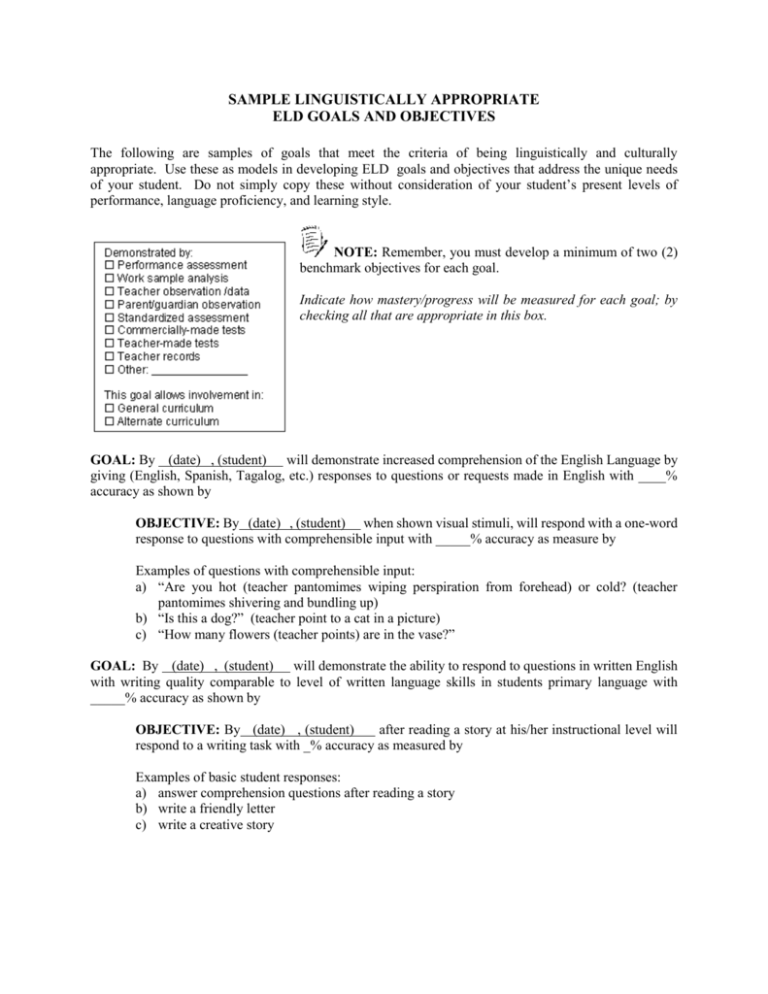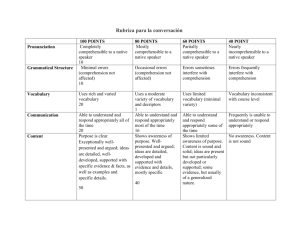File
advertisement

SAMPLE LINGUISTICALLY APPROPRIATE ELD GOALS AND OBJECTIVES The following are samples of goals that meet the criteria of being linguistically and culturally appropriate. Use these as models in developing ELD goals and objectives that address the unique needs of your student. Do not simply copy these without consideration of your student’s present levels of performance, language proficiency, and learning style. NOTE: Remember, you must develop a minimum of two (2) benchmark objectives for each goal. Indicate how mastery/progress will be measured for each goal; by checking all that are appropriate in this box. GOAL: By (date) , (student) will demonstrate increased comprehension of the English Language by giving (English, Spanish, Tagalog, etc.) responses to questions or requests made in English with ____% accuracy as shown by OBJECTIVE: By (date) , (student) when shown visual stimuli, will respond with a one-word response to questions with comprehensible input with _____% accuracy as measure by Examples of questions with comprehensible input: a) “Are you hot (teacher pantomimes wiping perspiration from forehead) or cold? (teacher pantomimes shivering and bundling up) b) “Is this a dog?” (teacher point to a cat in a picture) c) “How many flowers (teacher points) are in the vase?” GOAL: By (date) , (student) will demonstrate the ability to respond to questions in written English with writing quality comparable to level of written language skills in students primary language with _____% accuracy as shown by OBJECTIVE: By (date) , (student) after reading a story at his/her instructional level will respond to a writing task with _% accuracy as measured by Examples of basic student responses: a) answer comprehension questions after reading a story b) write a friendly letter c) write a creative story GOAL: By (date) , (student) will be able to read English at a comparable level to his/her reading proficiency in his/her primary language with ___% accuracy as demonstrated by OBJECTIVE: By (date) , (student) will be able to demonstrate comprehension of a reading selection at his/her readability level as measured by appropriate grade level curriculum assessment. GOAL: By (date) , (student) will be able to provide a response in English, either orally or in writing to stimuli that prompt critical and creative thinking with a response that shows elaboration and complex sentence structures ___% of the time as shown by OBJECTIVE: By (date) , (student) will be able to articulate responses to questions that require critical and creative thinking in the following four main areas: a) synthesis, b) evaluation, c) analysis, and d) application as measured by the following criteria: a) descriptive vocabulary, b) ability to elaborate and c) use of complex sentence structures within their response. GOAL: By (date) , (student) will respond in English to literal questions with short phrases, which may or may not be grammatically correct ___ out of ___ trials, with ____% accuracy as demonstrated by OBJECTIVE: By (date) , (student) when given comprehensible input, will respond to (who, what, where, when, how, and why) questions using short phrases with ___% accuracy as measured by Examples of basic questions with comprehensible input: a) “Where is the dog?” (sample student response: “by the tree”) b) “Who is walking the dog?” (sample student response: “the man”) c) “Why is the cat scared?” (sample student response: “sees the dog”) OBJECTIVE: By (date) , (student) in a natural environment, will be able to articulate and express on his/her own initiative, basic ideas and requests with ____% accuracy as measured by Examples of advanced student ideas and requests: a) “I am cold.” b) “I go to the bathroom?” c) “I like it!” Sample Culturally Appropriate ELD Goals and Objectives GOAL: By (date) , (student) will demonstrate increased reading comprehension in (English, Spanish, Tagalog, etc.) by responding correctly to ___out of ___ questions about a story with ___% accuracy as shown by OBJECTIVE: By (date) , (student) will identify two common themes/ main ideas and two differences in stories after reading _____ (independently, with modifications, listening, etc.) to four folk tales from different countries with ---% accuracy as measured by GOAL: By (date) , (student) will show improvement in writing fluency in (English, Spanish, Tagalog, etc.) by writing a (short story, paragraph, essay, sentence, etc.) using correct (punctuation, grammar, capitalization, spelling, etc.) with ____% accuracy as shown by OBJECTIVE: By (date) , (student) will respond by (dictating, writing a sentence, writing a paragraph, etc.) and share his/her personal responses to an open-ended question that draws upon life experiences, culture, and perceptions, after (listening to/reading) a story from (core/supplemental) curriculum with ___% accuracy as measured by GOAL: By (date) , (student) will show increased understanding of multiplication concepts taught in (English, Spanish, Tagalog, etc.) by achieving a score of ___% or higher on (teacher-made test, standardized test, work samples, etc.) in __out of __ attempts as shown by OBJECTIVE: By (date) , (student) will be able to use (graph paper, multi-link cubes, manipulatives, etc.) to demonstrate comprehension of the multiplication process after comparing and contrasting Mexican and Egyptian methods of multiplication as measured by




